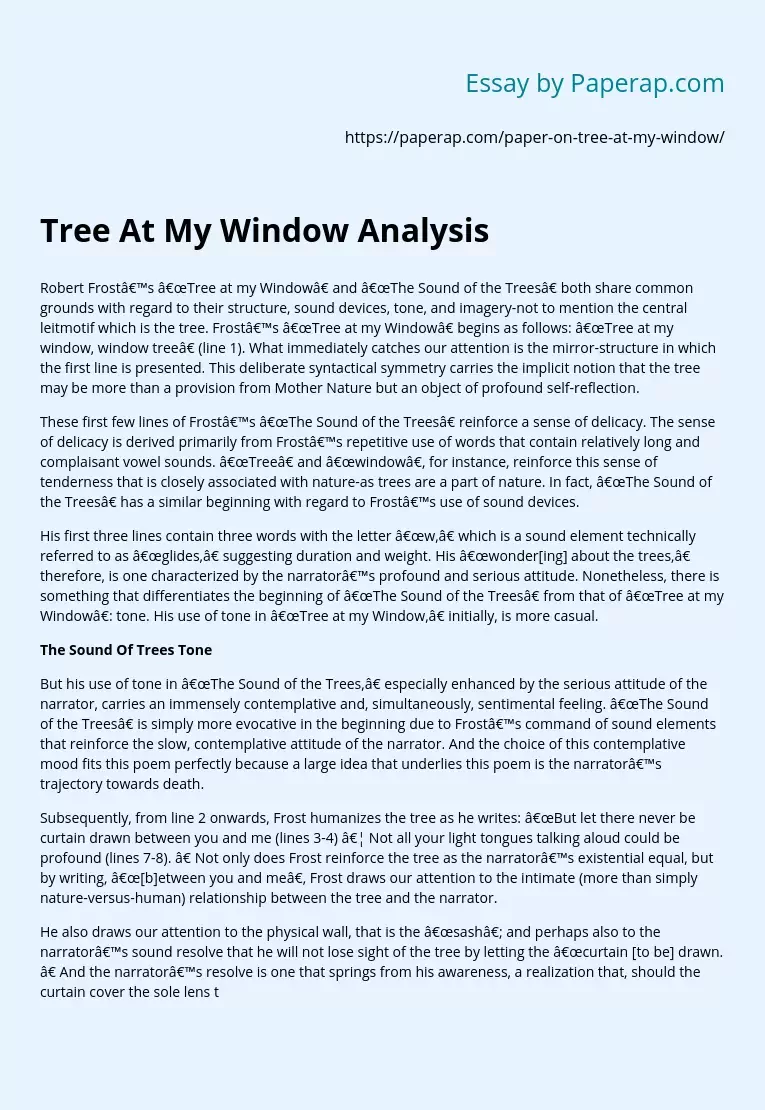Tree At My Window Analysis
Robert Frost’s “Tree at my Window” and “The Sound of the Trees” both share common grounds with regard to their structure, sound devices, tone, and imagery-not to mention the central leitmotif which is the tree. Frost’s “Tree at my Window” begins as follows: “Tree at my window, window tree” (line 1). What immediately catches our attention is the mirror-structure in which the first line is presented. This deliberate syntactical symmetry carries the implicit notion that the tree may be more than a provision from Mother Nature but an object of profound self-reflection.
These first few lines of Frost’s “The Sound of the Trees” reinforce a sense of delicacy. The sense of delicacy is derived primarily from Frost’s repetitive use of words that contain relatively long and complaisant vowel sounds. “Tree” and “window”, for instance, reinforce this sense of tenderness that is closely associated with nature-as trees are a part of nature. In fact, “The Sound of the Trees” has a similar beginning with regard to Frost’s use of sound devices.
His first three lines contain three words with the letter “w,” which is a sound element technically referred to as “glides,” suggesting duration and weight. His “wonder[ing] about the trees,” therefore, is one characterized by the narrator’s profound and serious attitude. Nonetheless, there is something that differentiates the beginning of “The Sound of the Trees” from that of “Tree at my Window”: tone. His use of tone in “Tree at my Window,” initially, is more casual.
The Sound Of Trees Tone
But his use of tone in “The Sound of the Trees,” especially enhanced by the serious attitude of the narrator, carries an immensely contemplative and, simultaneously, sentimental feeling. “The Sound of the Trees” is simply more evocative in the beginning due to Frost’s command of sound elements that reinforce the slow, contemplative attitude of the narrator. And the choice of this contemplative mood fits this poem perfectly because a large idea that underlies this poem is the narrator’s trajectory towards death.
Subsequently, from line 2 onwards, Frost humanizes the tree as he writes: “But let there never be curtain drawn between you and me (lines 3-4) … Not all your light tongues talking aloud could be profound (lines 7-8). ” Not only does Frost reinforce the tree as the narrator’s existential equal, but by writing, “[b]etween you and me”, Frost draws our attention to the intimate (more than simply nature-versus-human) relationship between the tree and the narrator.
He also draws our attention to the physical wall, that is the “sash”; and perhaps also to the narrator’s sound resolve that he will not lose sight of the tree by letting the “curtain [to be] drawn. ” And the narrator’s resolve is one that springs from his awareness, a realization that, should the curtain cover the sole lens through which he sees the tree that is his source of reflection and satisfaction, he will have lost something tremendously valuable. Therefore, lines 3-4 reinforce the significance of the tree to the narrator’s mind, reaffirming the tree’s role in this poem as a central leitmotif.
On top of all this, Frost uses certain techniques to instill in us a sense of familiarity and connection for this leitmotif that is the tree. Firstly, anthropomorphism of the tree establishes a sense of connection between the tree and the narrator. The narrator’s direct and explicit address to an abstract and nonhuman entity-the tree-effectively humanizes the tree, thereby establishing a stronger connection between the two. Secondly, by associating the tree with an entity as ubiquitous and diffuse as “cloud,” Frost establishes a sense of familiarity and tenderness.
The association of the leaves with diffuse clouds also evokes in us the notion of physical maneuverability and, conceptually, freedom. Whereas “Tree at my Window” evokes in us these positive emotions that comprise the narrator’s psychic experience, Frost runs with a far gloomier picture in his poem “The Sound of the Trees. ” As can be seen in both poems, Frost has a penchant for nature, and namely the kinds of revelations into human thoughts derived from his observation of nature.
In “The Sound of the Trees,” we are introduced to an emotionally debilitated narrator who is inclined to make “the reckless choice” as he sees the “trees sway, from the window or the door (lines 17-18). ” The reckless choice is most probably suicide, taking into consideration the overall context of the poem. What starts off as the narrator’s complaint about the “noise of these” trees soon develops into a more serious and depressing contemplation. With the final line, “But I shall be gone,” the narrator forebodes his death.
“The Sound of the Trees” is not a tale of perpetual gloom and despair; for instance, as is clear from lines 15-16, “My feet tug at the floor/And my head sways to my shoulder,” there are lyrical representations of a trees’ movements. And Frost’s close attention to the trees’ swaying movements is yet another commonality between the two tree poems. In “The Sound of the Trees,” these tree movements reflect clearly a need for contentment, which has to be pursued by a change, but the roots which “tug at the floor” perhaps are illustrating the limitations of that end.
Tree At My Window Analysis. (2019, Dec 05). Retrieved from https://paperap.com/paper-on-tree-at-my-window/

